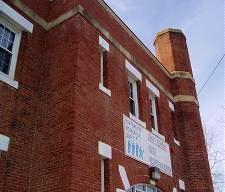|
FRESH STUFF DAILY |
|
|
||
|
|
||
|
|
||
|
SEE ALL SIGNED BOOKS by J. Dennis Robinson click here |
||
Page 1 of 5
It’s gone now, scarified to make way for the new Portsmouth Public Library. But for some, the old armory is not forgotten. Coastal defense expert Pete Payette offers a detailed history (1916 – 2005).of the rise and fall of the old armory building.
A History of the Old Portsmouth State Armory The Portsmouth State Armory stood in a quiet corner of downtown Portsmouth, NH at 175 Parrott Avenue, adjacent to the Portsmouth Middle School along the north bank of the South Mill Pond. It served the military from 1916 to 1958. Although in active use for only 42 years, the building was the center of military presence for the City of Portsmouth and the surrounding seacoast region. Although not built in the grand style of Victorian-era state armories elsewhere across the nation, the building was unique in the architectural annals of the city. The red brick building included an administrative section in the front known as the Head House. There was an entrance foyer and offices on two floors, a turreted tower/chimney on the front façade, and the large one-story Drill Hall, with a gabled slate roof, attached to the rear. The Drill Hall had an interior balcony level, an artillery vault for weapons lockup and a full basement under the reinforced floor. Before the state abandoned the building in 1958, there were layers of decorative arched brickwork and crenulations along the roofline of the Head House, giving it the look of a medieval castle. Building the Armory Portsmouth citizens began agitating for a state armory early in the 20th century to house the new local Coast Artillery unit of the state National Guard, formed in 1909. In 1911 arguments were made to convince the state legislature to approve a bill, chief among them the contention that Portsmouth, as a seaport, needed a coast artillery center, and that it would be a convenient location for units from Dover and Exeter to drill. Proponents argued that the existing facility, the so-called "Gun House" or Arsenal (located on Jenkins Court and South School Street, near the Haven School) was far too small. Weapons, equipment, and uniforms could no longer be safely stored at that location. (1) A bill finally passed both houses of the state legislature during the 1913 session calling for $20,000 in state appropriations to build an armory in Portsmouth, but it was vetoed by Governor Samuel D. Felker. Citizens of Portsmouth felt betrayed, and a delegation from the Portsmouth Board of Trade and Merchants' Exchange called on the Governor to review the bill again. Governor Felker replied that he felt the armory was not needed, but agreed that if the city could provide the site, the state would appropriate $15,000. The new bill passed the legislature again and the Governor then signed it. (2) The Portsmouth Herald printed a voting coupon in every paper for several days in August 1913 so that readers could suggest possible locations for the new building. Mayor Harry Yeaton named a special committee to pick the final site out of all the submissions. They selected a site on Marginal Road, now named Parrott Avenue, which abutted Haymarket Square. The City Council authorized the purchase of the 1.36 acre tract from the Peirce Estate, owners of the parcel, for $1 with the agreement that the surrounding property be forever held in trust as a park. Deeds were transferred to the state in December 1913. The governor and key figures discussed the architectural plans for the new armory and the status of the Gun House for months. Noted state architect Chase Whitcher created the design for was now the fourth new armory constructed in the state and the first state-owned building in Portsmouth. (3) Bids went out to several contractors. Local firm Sacco and Wood won with a low bid of $20,463. (4) The Governor and City Council accepted that with an additional $5000 from emergency funds. The state attorney general barred the proposal, however, and two weeks of negotiations brought the bid back down to meet the original $15,000 limit imposed by the appropriation. (5) Contractors broke ground in July 1914, and the Head House, or the front portion of the building, was completed shortly thereafter and accepted for use. CONTINUE to read PORTSMOUTH ARMORY
Please visit these SeacoastNH.com ad partners.
News about Portsmouth from Fosters.com |
| Friday, April 26, 2024 |


|
Copyright ® 1996-2020 SeacoastNH.com. All rights reserved. Privacy Statement
Site maintained by ad-cetera graphics

 Smuttynose Murders
Smuttynose Murders



















